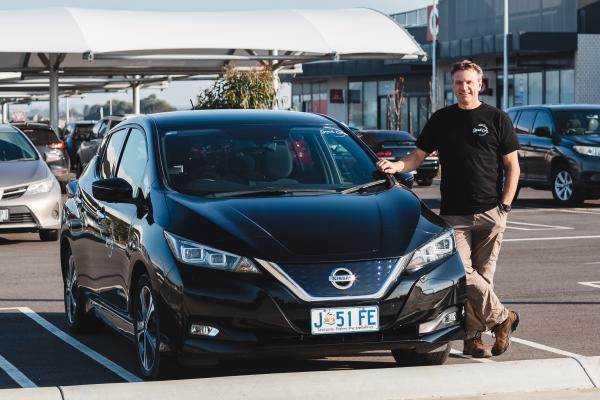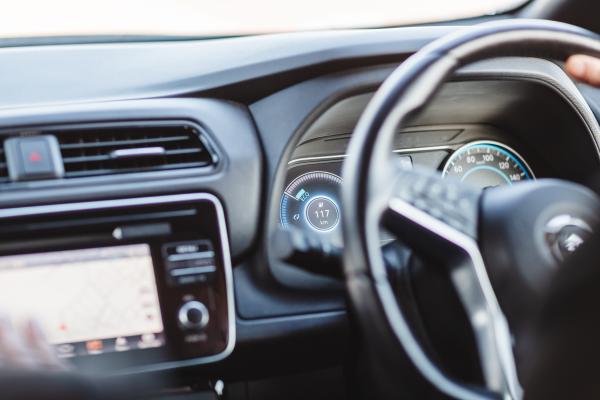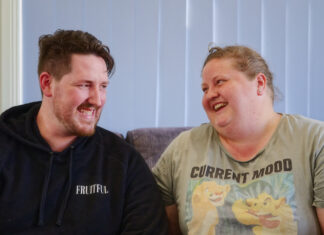As electric vehicles quietly pop up across Geelong, the groups behind a new bulk-buying partnership hope to get the city on the road to an “EV revolution”.
Torquay EV owner and supporter of the Good Car Company Gavin Hulme takes Luke Voogt for a test drive.
“Is it on?” I ask, after I push the start button of the Nissan Leaf. It’s quiet. Eerily quiet.
“That’s a question I get asked a lot,” replies Torquay EV owner Gavin Hulme.
“By law in Australia there has to be a sound an EV makes going at slow speed, so there’s actually a speaker that makes a noise just so people can hear it.
“In car parks and things like that, you can surprise people without it on.”
Gavin enjoys that peace and quiet with speaker off in the safety of his own driveway.
“I turn that noise, the parking sensors and the radio off, wind the windows down and listen to the nothing,” he says.
The battery is just over half full as we prepare to take off for a drive around Armstrong Creek and Grovedale.
“I didn’t charge it last night, I didn’t think it was needed. We’ve got 131 kilometres of range left,” Gavin says, pointing to the dashboard.
“That’s called a guess-o-metre – it’s guessing how far you can go based on how I was driving here and, I must admit, I was a bit zippy because it’s kind of fun.”
Our starting point is the newly-built Armstrong Creek Town Centre, which has free seven-kilowatt chargers.
“If you plug in here and do an hour of shopping that will be another 40 kilometres,” Gavin says.
“The good thing is there are more fast chargers coming all the time.
“Everyone asks how long it takes me to charge it and I say about one minute, because I just plug it in and go do my thing.”
The car takes several hours to charge fully overnight with a seven-kilowatt charger, although the process is a much slower 10 kilometres an hour with a regular power point.
“It’s a bit like your phone – you get home and you charge it,” Gavin explains.
“And the car’s always full in the morning.”
The full 234-kilometre range costs just over $8 in electricity, according to Gavin, compared to at least $25 for the same distance in a petrol car.
Or nothing, if you can afford home solar panels like Gavin.
“You’re driving on sunshine,” he says.
The car handles smoothly and I’m surprised to feel my back against the seat as I put the foot down to test the acceleration in a 100-kilometre zone.
The car makes a sound I can only describe as futuristic, as the motor whirs.
“It’s certainly got some zoom,” Gavin agrees, describing the Leaf as a “fast hatchback” that goes from zero to 100 in 7.5 seconds.
The heated steering wheel feels like luxury on my cold hands on a chilly winter morning, as does the heated seat, admittedly in comparison to my trusty but tired old 2005 VZ Commodore.
Perhaps the only glaring problem is the size and positioning of the rear-view mirror, which blocks a lot of my vision out the left side of the windscreen.
But that’s an easy problem to fix and has nothing to do with the car’s performance.
On a quieter street we test the Leaf’s E-pedal mode for driving without brakes.
“When we first bought ours I suggested to my wife, ‘let’s start in E-pedal mode’ because she was really worried about it,” Gavin says.
“So we started in it and I said, ‘ok, let’s try a different mode’ and she goes, ‘no, I like E-pedal! Don’t turn it off!’”
The mode uses the car’s regenerative engine braking at the start and friction breaks at the end, but you can still put your foot on the brake whenever needed.
Gavin likens the mode to driving a forklift or golf buggy.
“See, you’ve got the hang of it already,” he says.
I’m not a fan of the E-pedal, but the car’s other modes also use regenerative engine braking converting friction to electricity.
“You’re recapturing your kinetic energy rather than wasting it in heat,’ Gavin explains.
“When you take your foot off the accelerator, the electric motors turn back into generators and regenerate the electricity, putting it back into the battery – and that slows you down.”
Later, we discover this system has given me an added eight kilometres of range over a relatively short test drive.
“Because we’re not using the real brakes, it means the maintenance is a lot less,” Gavin adds.
“You don’t have to change your brake pads very often because they hardly get used.”
And EVs have other maintenance benefits, according to Gavin.
“Because there’s no internal combustion engine, there’s no fuel filters, spark plugs, clutch, oil filters, high-tension leads and catalytic converters,” he says.
“There is oil in there but it gets changed every 200,000 kilometres because the engine doesn’t get hot – that’s what kills your oil.”
EVs are quietly starting to pop up across Geelong.
“There’s an EV,” Gavin says, pointing to a Tesla Model 3.
“You don’t realise how many EVs are actually around, especially a car like this – it doesn’t look like an EV.”
According federal government, transport is Australia’s third largest source of carbon emissions at 17 per cent of total emissions, per year.
An overwhelming scientific consensus says that human carbon emissions are leading to irreversible climate change.
But Australians are purchasing EVs at a minuscule rate compared to other parts of the world.
By one measure, they accounted for 0.7 per cent of new car sales in Australia in 2020, compared to five per cent in China and 3.5 per cent in the European Union.
So what’s stopping EVs from taking off in Australia? Mainly, the price.
“There is a concept that EVs are for the rich, because of the Teslas and the [Jaguar] I-pacers – they’re all about $150,000,” Gavin says.
The Leaf, now Nissan’s only hatchback, will set you back $53,190, more the triple its cheapest petrol-driven competitor, the Kia Picanto at $15,690.
The model is about twice the price of a Toyota Corolla hatchback, which also has a slightly more expensive hybrid version.
And the batteries, which lose about three per cent capacity a year, can cost about $10,000 to replace.
But manufacturers are devising cheaper options, like refurbishing used batteries, Gavin says.
A lack of federal and state government incentives does not help, he says.
“Unlike other countries around the world, there was no incentive for new EVs in Australia.
“So the manufacturers were like, ‘well, why would we bring one here? We know that we’re going to sell it easier somewhere else’.”
And a scarcity of used EVs means their value does not depreciate as fast as a petrol-driven car.
“EVs are holding their value really well. They’re really hard to buy second hand,” Gavin says.
But this month the Good Car Company has partnered with Geelong Sustainability in a project to sell low-kilometre used EVs bulk-bought from Japan.
“It just helps bring that cost down,” says Gavin, who owns an audio-visual company but is also promoting the Good Car Company as a side job and “passion” this month.
“That’s the philosophy within the company, to bring E-mobility to the masses.”
The 2017-2019 Leaf we tested last Friday is available for $38,998 through the program, while an older model with a 150-kilometre range costs $26,777.
But fear and misunderstanding of how EVs work are also strong deterrents, according Gavin.
“You see it often in online forums, people say, ‘I’m not going to by an EV until they’re the same price as a [petrol] car and there are charging stations everywhere’,” he says.
“But you don’t need a charging station next to your house. Your house is one.”
A trip across, say, the Nullarbor Plains is impossible without stopping at almost every caravan park on the way to charge, Gavin admits.
But the car can complete a return trip to Melbourne.
“You can drive to Sydney fairly easy – it just takes a little bit longer,” Gavin says.
“It’s perfect for a daily commuter – taking the kids to school and things like that. If you go on a longer journey, you just need to plan a bit more.
“I can’t remember the last time we went to the petrol station, it was maybe just to steal some air for the tires or get a coffee. It’s nice not having to go there.”










